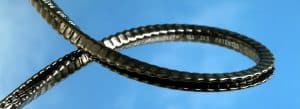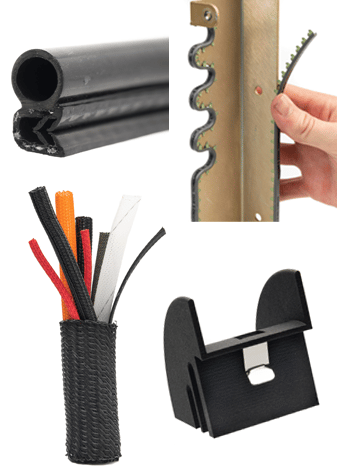Fire is a deadly hazard in trains. As the rail infrastructure is expanded and upgraded in Europe, the US, and around the world more and more attention is being placed on passenger safety and fire mitigation regarding materials.

Wiring is critical. Trains have miles of cabling that transmits critical data between onboard and outside management systems. It is the central nervous system of the train connecting everything. These systems include driver's cab controls, passenger monitors, train-land communication/tracking interfaces, automatic door control, etc. They all have to work seamlessly and even communicate with each other when appropriate to ensure smooth safe transit.
The wiring to control this is mostly invisible, hidden in confined spaces like walls, floors, and ceilings. These confined spaces are defined by sharp and most often metallic edges. When wires chafe on these edges, it can cause loss of data and/or systems failures but it can also cause short circuits that can lead to arcing, sparking, and fires.
Fires have the potential to make everything worse in the event of an accident so governments, transit companies, and OEM’s work hand in hand to mitigate this risk with Flame, Smoke, and Toxicity (FST) regulations.
The result is a complex mix of fire requirements – “FST” for short. FST standards set parameters on how components/materials react to flames and what smoke and toxicity they emit when exposed to it. The core standards for transit materials include DIN EN 45545-2 in Europe and ASTM and NFPA standards in the US. These are designed to make the traveling public safer in the event of a catastrophic event like a fire.
For edge protection (aka grommet edging) rail OEM’s traditionally have used either PVC edge trim or a glued in nylon grommet. Both have significant drawbacks that have made them unsuitable for continued use:
- PVC is not FST compliant and also has issues with chlorine off-gassing at elevated temperatures like engine rooms and electronic cabinets
- Glued nylon grommets are not FST compliant, plus even worse, they have a long slow application process, high re-work rates, and suffer from material degradation over time (both the grommet and the adhesive). If there were a fire, the nylon grommets and adhesives can cause an increased toxic load and smoke development.
DTi Solution
DTi has a proven best in class solution, Spring-Fast® SL-FST, which prevents wire abrasion. First developed for computers and IT equipment prior to the millennium, it has proved it can perform under challenging conditions like high vibration, movement, and extreme temperature fluctuations that are found not just in rail, but also in aerospace and automotive applications.

SL-FST is made from a steel core with castles, or gripping teeth, that angle into the metal edge creating a gripping force and edge retention without adhesives. The steel core is encapsulated with a durable non-flammable thermoplastic elastomer, which is flame, smoke, and toxicity (FST) compliant and halogen-free. This meets the strict requirements of DIN EN 45545-2 and is qualified for Hazard Levels 2 and 3 – the toughest requirements within the DIN.
Core Benefits
- The application is simple fast and easy using just finger pressure.
- No adhesives or solvents increase productivity.
- Minimal install time vs. nylon grommets creates install cost savings of approx. 49%.
- Strong edge grip and can easily be removed and repositioned without loss of retention.
- SL-FST cannot dry out, become porous or brittle – In contrast to nylon.
- SL-FST is a green alternative – no harmful VOC’s (adhesives/solvents) protects workers- no need for safety gear/extra ventilation and or HAZMAT disposal concerns
In Europe, SL-FST grommet use is growing fast for several reasons. More and more light rail and high-speed lines are being built in Europe which is, at least, partly driven by concerns about climate change and how mass transit could help. A geographic element also helps as many sections of European rail tracks run through tunnels which compounds the risk of fire and smoke toxicity exposure considerably. The result is that component/material fire safety requirements are particularly high.
Because SL-FST is optimized for low flammability, low smoke, and low toxicity, it meets EU requirements, and the old outdated PVC trim and nylon grommets simply cannot compare. As a result, SL-FST is increasingly being adopted by European rail and transit manufacturers and operators.
Download the SL-FST Transit & Rail Series datasheet and request free samples here.

